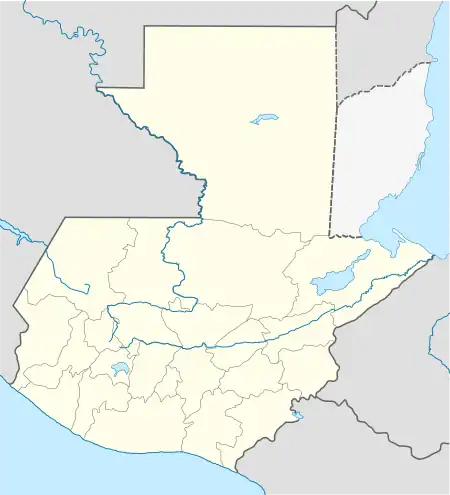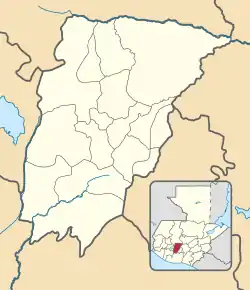Zaragoza | |
|---|---|
Municipality and town | |
 Zaragoza Location in Guatemala  Zaragoza Location in Chimaltenango Department | |
| Coordinates: 14°39′N 90°53′W / 14.650°N 90.883°W | |
| Country | |
| Department | |
| Government | |
| • Mayor | Juan Francisco Cardenas Argueta |
| Area | |
| • Total | 19.0 sq mi (49.1 km2) |
| Population (2018 census)[2] | |
| • Total | 24,022 |
| • Density | 1,300/sq mi (490/km2) |
| Time zone | UTC+6 (Central Time) |
| Climate | Cwb |
Zaragoza (Spanish pronunciation: [saɾaˈɣosa]) is a town, with a population of 11,176 (2018 census),[3] and a municipality in the Chimaltenango department of Guatemala.
History
The early name of the valley where Zaragoza is located was Chicaj, which evolved into Chicoj or Chixoc, which in kakchiquel means "Francisco Oj", who was the kakchikel chief who owner the land in 1711. It was also known as the "Peach Valley". In 1761 several Spanish families wanted to move to that place and commissioned several members to get government approval; once the permission was granted, the villa was called "Valle de Nuestra Señora del Pilar de Heredia" (English:"Our Lady of the Pond of Heredia Valley)".[lower-alpha 1]
One of the earliest references to the town during the Spanish Colony can be found in Compendio de la Historia de la Ciudad de Guatemala (English:Brief account of Guatemala City history)[4] who in 1818 wrote Domingo Juarros. He pointed out that the Spanish villa belong to Patzicía's "curato" in the mayor municipality of Chimaltenango.[4]
After the independence of Central America in 1821, the Constitution of the State of Guatemala from 11 October 1825, specified the town in the territory, and the villa appeared in Circuit #8 (Sacatepéquez), within Chimaltenango and then, by the Constitutional Assembly of 1839, the town was assigned to Chimaltenango Department. Finally, by an executive action of 27 January 1892, the town was elevated to municipality, and its name was changed to "Zaragoza" because most of the Spanish people who lived there was from Zaragoza, Spain.
In 1895 British archeologist Alfred Percival Maudslay and his wife, Anne Cary Maudslay, visited Zaragoza on their way from Antigua Guatemala to Santiago Atitlán. Anne Maudslay told her adventure in the book A glimpse at Guatemala, from the Victorian Era perspective: "After riding a mile or two along a road bordered by cottages bosomed in fruit trees we rose to a bleak tableland. It was one of the very few days of unpleasant weather which we experience during the whole of our journey; a fierce wind raised clouds of dust and rustled through the ugly dry rastrojos, or stubbles of Indian corn, which covered the plain. We passed through the little Indian town of Zaragoza, chiefly noted for the manufacture of aparejos, the native pack-saddles. I have been told that the Indians here have such a liking for dried alligator meat as a Lenten fare that the vendors of the highly-perfumed delicacy have to be locked up in the carcel (English: Jail for protection and sell the meat through the prison bars. The streets were full of gaily-dressed people assembled for a fiesta, and dancing was going on in a shed, to a monotonous sound of a marimba. We were not tempted to loiter for long, and rode on again over the dull plan to uninteresting town of Chimaltenango."[5]
Administrative division
| Classification | List |
|---|---|
| Villages | Las Lomas, Puerta Abajo, Agua Dulce, Mancheren, Las Colmenas, El Cuntic, Rincón Grande, Joya Grande, Potrerillos, Rincón Chiquito, Tululché and El Llano |
| Settlements | Hierba Buena, Laguna Seca and El Perique |
| Residential neighborhoods | El Pilar, Las Ilusiones, Lo de Pérez, Nueva Esperanza and La Colonia 29 de Diciembre |
| Hacienda | Los Jutes |
Tourism and recreation
The following is the list of the main celebrations in the municipality:
| Month | Day | Description |
|---|---|---|
| January | 1 | New Year: Masquerade dance and free public concert |
| 15 | Peregrination to visit Esquipulas. Rincón Chiquito and Joya Grande villages celebrate their annual fair in honor to Esquipulas Black Christ. | |
| February | 2 | "Virgen de Candelaria" prayers and Mass |
| Variable | Canival | |
| March and April | Variable | Lent: processions with "Jesús del Pensamiento" (English:Jeus of the Thought), Vía crucis every Friday, and culinary dishes. |
| May | 3 | Day of the Cross: construction workers build and ornament a cross on every single construction site in town. The town itself celebrates the Cruz de Pachojo (English:Pachojo's Cross). |
| 10 | Mother's day | |
| June | 17 | Father's day |
| September | 1 | Opening ceremony of Independence celebrations |
| 4 to 8 | Several contests take place. | |
| 13 and 14 | Torch races and civic ceremonies | |
| 15 | Independence Day: Civic parade | |
| 30 | Closing ceremony of Independence celebrations | |
| October | 1 | Horse parade and cowboy night |
| 7 [lower-alpha 2] | Zaragoza's queen crowning | |
| 8 [lower-alpha 3] | Fair parade | |
| 11 | "Virgen del Pilar" (English: Virgin of the Pillar) procession | |
| 12 | Major Mass | |
| 13 | Public free celebration and Belt race. A second procession comes out at night. | |
| 14 | Closing ball, called "El Baile de Antaño" (English: "The Forgone era Ball") | |
| November | 1 | Day of the dead: Celebrated with visits to the local cemetery, custom kite flying and traditional food. |
| December | 24 | Christmas Eve |
| 25 | Christmas: Masquerade dance and free public concert | |
| 29 | Annual fair |
Climate
Zaragoza has a subtropical highland climate (Köppen: Cwb).
| Climate data for Zaragoza | |||||||||||||
|---|---|---|---|---|---|---|---|---|---|---|---|---|---|
| Month | Jan | Feb | Mar | Apr | May | Jun | Jul | Aug | Sep | Oct | Nov | Dec | Year |
| Mean daily maximum °C (°F) | 20.0 (68.0) |
21.0 (69.8) |
22.4 (72.3) |
23.3 (73.9) |
22.6 (72.7) |
20.8 (69.4) |
21.1 (70.0) |
21.6 (70.9) |
20.8 (69.4) |
20.4 (68.7) |
20.1 (68.2) |
20.1 (68.2) |
21.2 (70.1) |
| Daily mean °C (°F) | 14.2 (57.6) |
14.8 (58.6) |
16.1 (61.0) |
17.5 (63.5) |
17.7 (63.9) |
16.8 (62.2) |
16.8 (62.2) |
16.8 (62.2) |
16.5 (61.7) |
16.0 (60.8) |
15.0 (59.0) |
14.5 (58.1) |
16.1 (60.9) |
| Mean daily minimum °C (°F) | 8.5 (47.3) |
8.7 (47.7) |
9.9 (49.8) |
11.7 (53.1) |
12.8 (55.0) |
12.9 (55.2) |
12.5 (54.5) |
12.1 (53.8) |
12.2 (54.0) |
11.7 (53.1) |
10.0 (50.0) |
8.9 (48.0) |
11.0 (51.8) |
| Average precipitation mm (inches) | 4 (0.2) |
6 (0.2) |
7 (0.3) |
37 (1.5) |
121 (4.8) |
303 (11.9) |
226 (8.9) |
224 (8.8) |
287 (11.3) |
154 (6.1) |
45 (1.8) |
10 (0.4) |
1,424 (56.2) |
| Source: Climate-Data.org[6] | |||||||||||||
Winds speed average is 13,5 km/h between January and June, and of 25 km/h between July and December, while the daily sun light average is 6,6 h.[7]
Geographic location
Located in the middle of Chimaltenango Department with an area of 49.1 km². It is completely surrounded by Chimaltenango municipalities:
Sister cities
See also
Notes and references
- ↑ In the Central America General Archives in Guatemala City there is a file called Autos sobre la fundación del pueblo, más tarde villa de nuestra señora del Pilar de Zaragoza de Heredia (English: Proceedings of the foundation of the town, later village, or Our Lady of the Pont of Zaragoza de Heredia) from 1762. In the file specifies that the town was founded in the early 18th century by a group of Spaniards that bouth the land. According to the law of the time, the town was designated as a "villa" because its main citizens were Spaniards and not natives. The natives lived in towns.
- ↑ Or the last Saturday of September or first of October.
- ↑ Or the second Sunday of October.
References
- 1 2 "Cities twinned with Zaragoza. Zaragoza City Hall". Zaragoza.es (in Spanish). Retrieved 2011-04-10.
- ↑ CityPopulation.de Population of departments and municipalities in Guatemala
- ↑ Citypopulation.de Population of cities & towns in Guatemala
- 1 2 Juarros 1818, p. 345.
- ↑ Maudslay & Maudslay 1899, p. 41.
- ↑ "Climate: Zaragoza". Climate-Data.org. Retrieved 19 September 2015.
- ↑ "Clima de Chimaltenango, Guatemala". Instituto de Sismología, Vulcanología, Meteorología e Hidrografía (INSIVUMEH) (in Spanish). Guatemala. 2010.
- 1 2 "Municipios del departamento de Chimaltenango". SEGEPLAN (in Spanish). Guatemala. Archived from the original on 7 July 2015. Retrieved 22 July 2015.
Bibliography
- Juarros, Domingo (1818). Compendio de la historia de la Ciudad de Guatemala (in Spanish). Guatemala: Ignacio Beteta.
Br. Juarros was a secular priest and Guatemala's Archdiocese sinodal examiner
- Maudslay, Alfred Percival; Maudslay, Anne Cary (1899). A glimpse at Guatemala, and some notes on the ancient monuments of Central America (PDF). London, UK: John Murray.
External links
- (in Spanish) La Villa de Zaragoza y toda su historia
